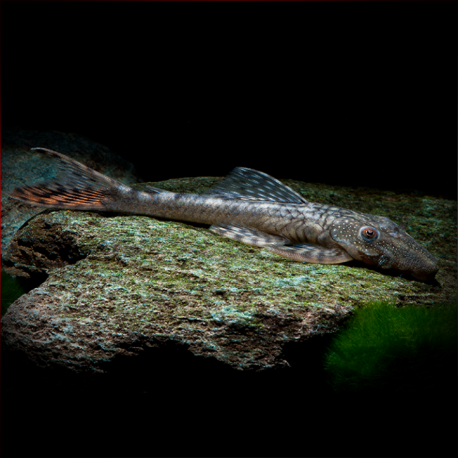More info
Datasheet
| Minimum Tank Size | 70 litres / 18.49 US gallons |
| Maximum Size | 12.0cm / 4.72inches |
| Temperature | 24°C / 75.20°F - 28°C / 82.40°F |
| Hardness | 2-10ºdH |
| pH | 6.0-7.4 |
General Description: Lasiancistrus tentaculatus, also known as L092 or L194, is a species of Loricariid catfish native to Colombia and Venezuela. This recently described species is easily distinguished by the presence of whiskerlike odontotes among the cheek odontotes, a unique feature not found in other Loricariids.
Aquarium Setup: For optimal care of Lasiancistrus tentaculatus, a biotope setup mimicking its natural habitat is recommended. A tank with loads of driftwood of varying shapes and sizes, arranged randomly with a sand substrate, is ideal. The species prefers dim lighting and does not require aquatic plants, as they may be consumed. Well-oxygenated water with a good flow and some surface vegetation are beneficial for their well-being (see table for specific water conditions).
Behaviour: Known for its placid nature, Lasiancistrus tentaculatus is an excellent addition to a South American community tank. This species is not particularly territorial, allowing for peaceful cohabitation with various tankmates such as characins, peaceful cichlids, Corydoras, and other Loricariids. They can be kept in groups within a wide range of tank sizes.
Feeding and Diet: As a primary xylophagus species, Lasiancistrus tentaculatus relies on wood as a vital food source. Their intestines are known to be filled with wood chips, aided in digestion by specialized gut bacteria. Supplementing their diet with greenery like cucumber, courgette, blanched spinach, and sinking dried foods is recommended for a balanced nutritional intake.
Reproduction & Dimorphism: Limited information is available on the breeding habits of Lasiancistrus tentaculatus. However, it is known that they spawn eggs in caves or crevices, with fry requiring access to both wood and greenery for optimal growth. Mature males develop Ancistrus-like tentacles around the mouth, distinguishing them from females, who appear broader when full of eggs.
Habitat and Distribution: This riverine species primarily inhabits driftwood snags within the river systems of Colombia and Venezuela. The fish's adaptation to xylophagy is believed to have evolved due to the abundance of fallen wood in their habitat, providing them with a competitive advantage in low-light environments.

